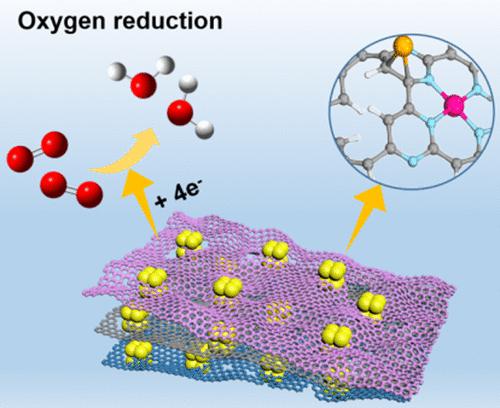当前位置:
X-MOL 学术
›
ACS Appl. Nano Mater.
›
论文详情
Our official English website, www.x-mol.net, welcomes your
feedback! (Note: you will need to create a separate account there.)
Pt Nanoparticles Supported on Iron and Nitrogen-Doped Holey Graphene for Boosting ORR Performance
ACS Applied Nano Materials ( IF 5.3 ) Pub Date : 2023-06-06 , DOI: 10.1021/acsanm.3c01502 Zijian Gao 1 , Zhuo Chen 1 , Xinxing Zhan 1 , Lingyun Zhou 2 , Yadian Xie 2 , Xiaohua Yang 3, 4 , Juan Tian 1 , Gaixia Zhang 3 , Shuhui Sun 4 , Xin Tong 1
ACS Applied Nano Materials ( IF 5.3 ) Pub Date : 2023-06-06 , DOI: 10.1021/acsanm.3c01502 Zijian Gao 1 , Zhuo Chen 1 , Xinxing Zhan 1 , Lingyun Zhou 2 , Yadian Xie 2 , Xiaohua Yang 3, 4 , Juan Tian 1 , Gaixia Zhang 3 , Shuhui Sun 4 , Xin Tong 1
Affiliation

|
Developing low-platinum catalysts is considered a promising strategy to facilitate the commercialization of fuel cells. However, the electrochemical performance of such materials is often hindered by mass-transfer issues. In this study, platinum nanoparticles supported on iron and nitrogen-doped holey graphene (Pt/Fe, N-HG) were synthesized by a simple method and used as an oxygen reduction reaction (ORR) catalyst. The unique holey structure and the co-doping of Fe and N atoms are proved beneficial for not only the formation of Pt nanoparticles but also enhancing the electrochemical performance of the catalyst. Density functional theory calculations indicate that the co-doping of Fe and N atoms increases the ability to adsorb Pt, as well as enhances the Pt adsorption of O2 and oxygen-containing intermediates in the ORR. This study presents a novel approach for the controllable synthesis of multidoped holey graphene-based electrocatalysts, with optimized surface holey structures and electrochemical performances. These findings offer significant insights into the development of efficient catalysts for fuel cell applications.
中文翻译:

铁和氮掺杂多孔石墨烯负载的 Pt 纳米粒子可提高 ORR 性能
开发低铂催化剂被认为是促进燃料电池商业化的一个有前途的策略。然而,此类材料的电化学性能常常受到传质问题的阻碍。在这项研究中,通过简单的方法合成了铁和氮掺杂多孔石墨烯(Pt/Fe,N-HG)负载的铂纳米粒子,并将其用作氧还原反应(ORR)催化剂。独特的多孔结构以及Fe和N原子的共掺杂被证明不仅有利于Pt纳米颗粒的形成,而且有利于提高催化剂的电化学性能。密度泛函理论计算表明Fe和N原子的共掺杂增加了Pt的吸附能力,同时增强了O 2对Pt的吸附和ORR中的含氧中间体。这项研究提出了一种可控合成多掺杂多孔石墨烯基电催化剂的新方法,具有优化的表面多孔结构和电化学性能。这些发现为燃料电池应用高效催化剂的开发提供了重要的见解。
更新日期:2023-06-06
中文翻译:

铁和氮掺杂多孔石墨烯负载的 Pt 纳米粒子可提高 ORR 性能
开发低铂催化剂被认为是促进燃料电池商业化的一个有前途的策略。然而,此类材料的电化学性能常常受到传质问题的阻碍。在这项研究中,通过简单的方法合成了铁和氮掺杂多孔石墨烯(Pt/Fe,N-HG)负载的铂纳米粒子,并将其用作氧还原反应(ORR)催化剂。独特的多孔结构以及Fe和N原子的共掺杂被证明不仅有利于Pt纳米颗粒的形成,而且有利于提高催化剂的电化学性能。密度泛函理论计算表明Fe和N原子的共掺杂增加了Pt的吸附能力,同时增强了O 2对Pt的吸附和ORR中的含氧中间体。这项研究提出了一种可控合成多掺杂多孔石墨烯基电催化剂的新方法,具有优化的表面多孔结构和电化学性能。这些发现为燃料电池应用高效催化剂的开发提供了重要的见解。

































 京公网安备 11010802027423号
京公网安备 11010802027423号